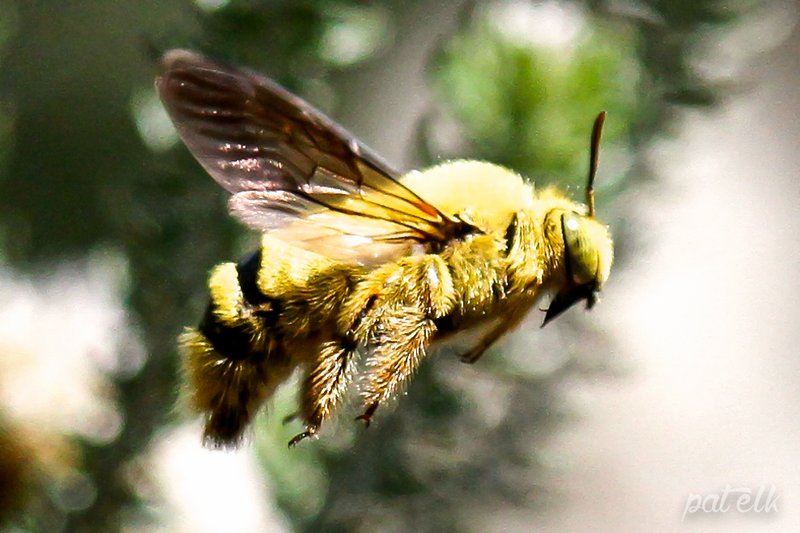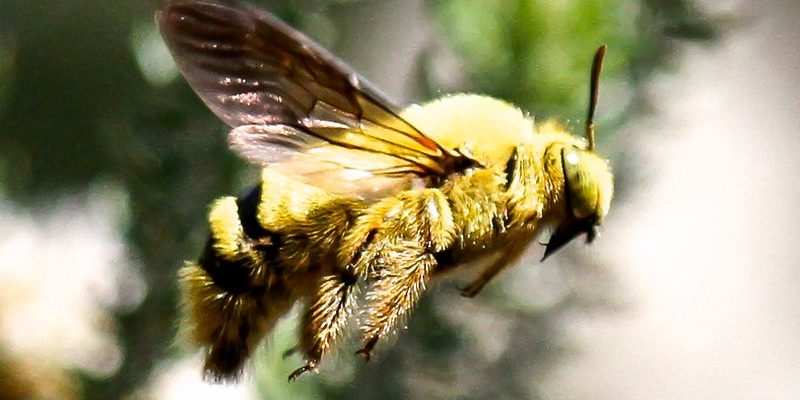
Think of carpenter bees as the misunderstood artists of the bee world. Instead of making honey, they carve out homes in wood, which can create some concerns for homeowners. But before we jump to conclusions about these little creatures, let’s clear up some misconceptions. Grab a cup of coffee, and let’s dive into the most common myths surrounding carpenter bees. You might be surprised by what we discover!
Myth 1: Carpenter Bees Are Just Like Other Bees
You might be wondering how carpenter bees compare to more familiar types like honeybees or bumblebees. While they belong to the bee family, carpenter bees have unique traits that set them apart. For starters, they don’t live in hives. Instead, these bees are solitary creatures, preferring to create their own nests in wood.
Carpenter bees are also larger than most honeybees, often resembling bumblebees but with shiny, hairless abdomens. This shiny appearance sometimes leads people to think they’re wasps, which is another misconception entirely. Understanding these differences helps us appreciate their role in the ecosystem without jumping to conclusions about their behavior.
Moreover, despite their size and sometimes intimidating appearance, carpenter bees aren’t aggressive. They rarely sting unless they feel threatened. So, if you spot one buzzing around your porch or garden, keep calm! They’re usually just minding their business, looking for wood to dig into for nesting.
Myth 2: Carpenter Bees Destroy Wooden Structures
The myth that carpenter bees destroy houses is where a lot of misinformation starts. Yes, they do make nests in wood, but they don’t eat it like termites. Instead, they bore holes into wood to create nesting chambers. These holes can be unsightly, especially on wooden decks or eaves.
However, it’s important to consider that while they can cause cosmetic damage, carpenter bees are generally not a structural threat. The damage becomes significant only when there is a large population of them nesting in one area. Think of it like a few stray dogs in a neighborhood: a few barking now and then don’t cause a ruckus, but a whole pack might be a problem!
Preventative measures, like sealing wood surfaces or using hardwoods, can help deter carpenter bees from nesting. If they do make their way inside, it’s usually a simple fix to repair the small holes they create.
Myth 3: Carpenter Bees Are Bad for Gardens
You might think, “If these bees are boring into my wood, they must be bad for my garden too!” But here’s the thing: carpenter bees can actually be beneficial for your flowers and plants. They are excellent pollinators, just like their more famous honeybee cousins.
When they visit flowers, they gather nectar and pollen, transferring it from one bloom to another as they flit about. This process is crucial for helping plants reproduce, and many gardeners actively welcome carpenter bees into their spaces. Having them around can lead to more vibrant and fruitful gardens, so you might want to rethink any negative feelings you have toward them!
If you’re concerned about them nesting too close to your garden, plant flowers further away from wooden structures. This way, you can enjoy their pollination without having to worry about unwanted holes in your wood.
Myth 4: All Carpenter Bees Are the Same
Did you know there are actually several species of carpenter bees? The most common types include the Eastern carpenter bee and the Western carpenter bee. While they share some similarities, there are distinct differences between them, especially in their nesting behaviors and preferences.
For instance, Eastern carpenter bees are often found in coastal areas, while Western carpenter bees prefer the drier climates of the western states. Their nesting habits also vary slightly; some might choose to nest in pre-existing holes from old woodpecker nests, while others dig fresh ones. Understanding these differences can help in knowing how to manage your surroundings if you encounter them.
Also, some species of carpenter bees are more aggressive than others. However, most are harmless unless provoked. So, when you see a carpenter bee, take a moment to identify which type it is; it might save you from unnecessary stress!
Myth 5: Carpenter Bees Are All Pests
Honestly, the term “pest” gets thrown around a lot when it comes to carpenter bees. While they can cause some issues for wooden structures, labeling them as pests ignores their valuable role in our ecosystem. If you think about it, every species plays a part in maintaining the balance of nature, and carpenter bees are no exception.
Their role as pollinators is significant for many flowering plants. This helps not only gardens but also local agriculture. Some plants, like tomatoes and blueberries, thrive with the help of carpenter bees. Plus, they’re really quite fascinating creatures! Watching them zoom around your garden can be a delightful experience.
Instead of viewing carpenter bees as nuisances, consider them part of the intricate web of life that helps sustain your garden and local environment. With a little understanding, you can appreciate their presence without fear.
Myth 6: You Can Just Spray Them Away
If you find carpenter bees annoying, your first impulse might be to reach for a can of insect spray. But hold on a second! Spraying them isn’t the best solution for a few reasons. First off, many insecticides can harm not only bees but also beneficial insects and plants in your garden.
Instead of reaching for chemicals, try non-lethal methods. If they’re nesting in wood, sealing those areas can prevent them from coming back. Additionally, creating bee-friendly environments, like planting native flowers, can help keep carpenter bees happily buzzing away from your structures.
If you do feel the need to manage them, consider contacting a local pest control expert. They can provide safer options that minimize harm to these beneficial insects while addressing your concerns.
Wrapping It All Up
Carpenter bees might not be everyone’s favorite garden visitor, but understanding them can change your perspective. They’re not just pests; they’re essential pollinators and unique creatures with their own role in the ecosystem. By debunking these common myths about carpenter bees, we can demystify their behavior and appreciate their contribution to our world.
So the next time you hear a buzz around your yard, take a moment to appreciate this fascinating insect. With a little knowledge, you can coexist peacefully with carpenter bees, embracing their role in nature while protecting your home.

